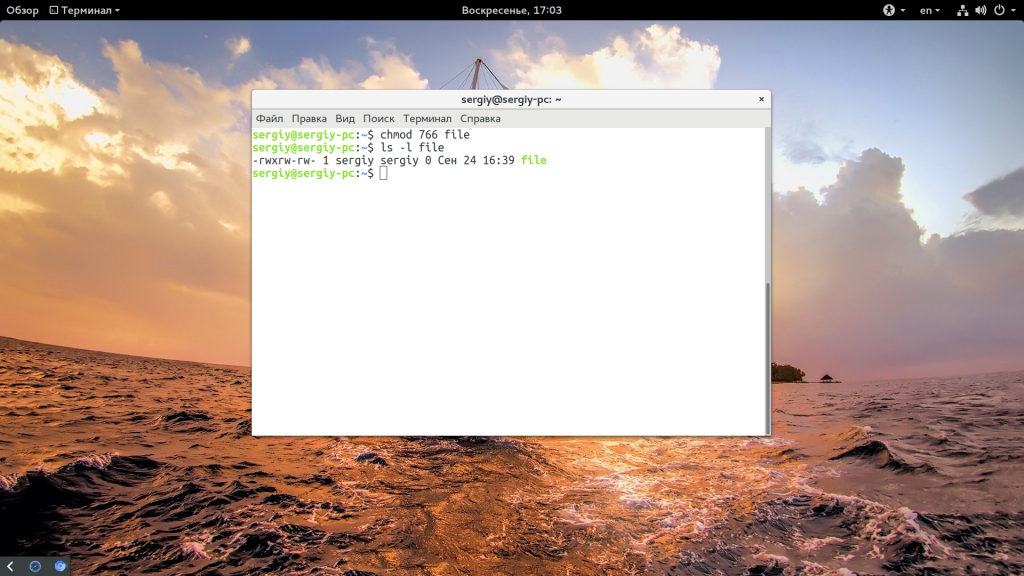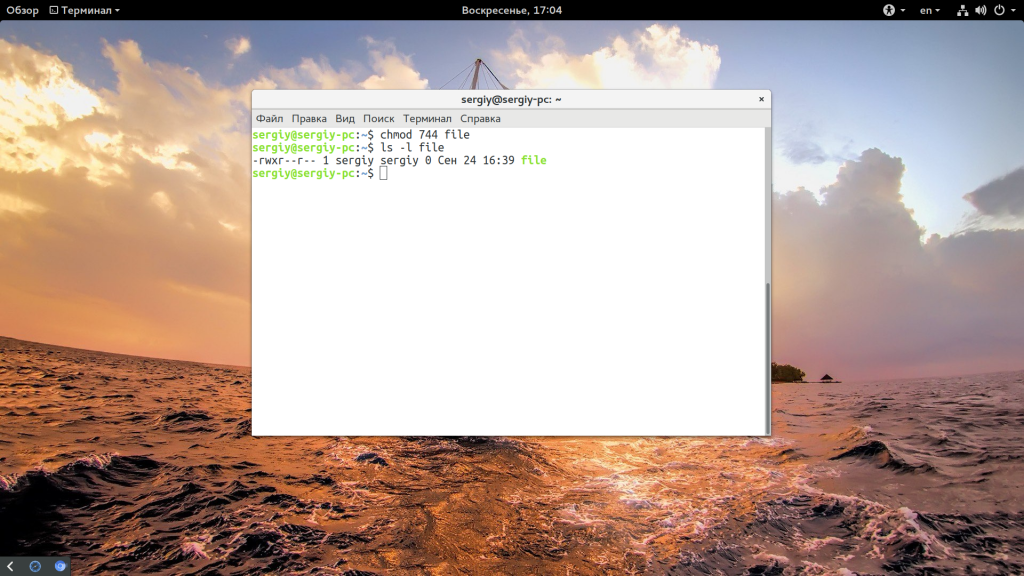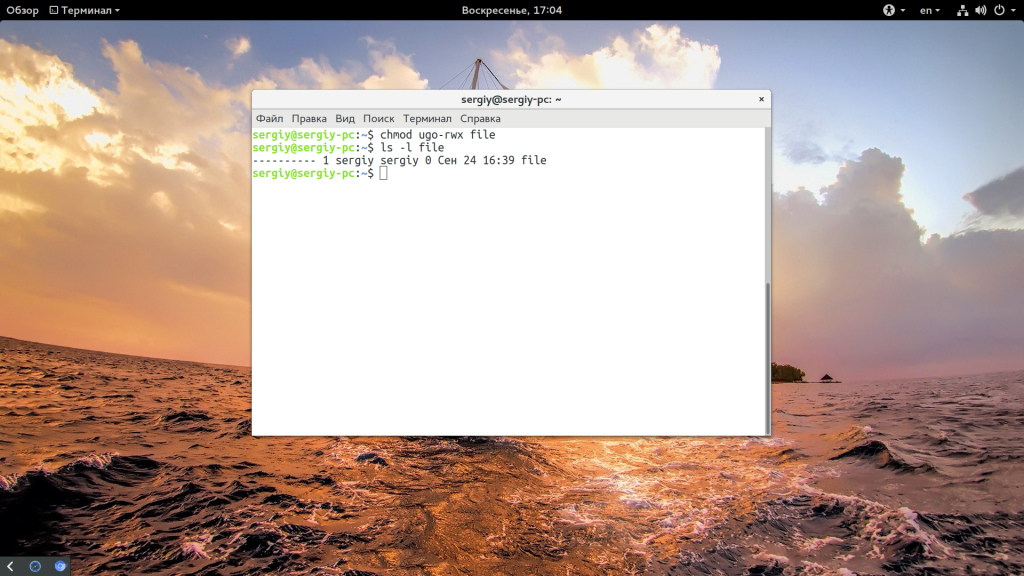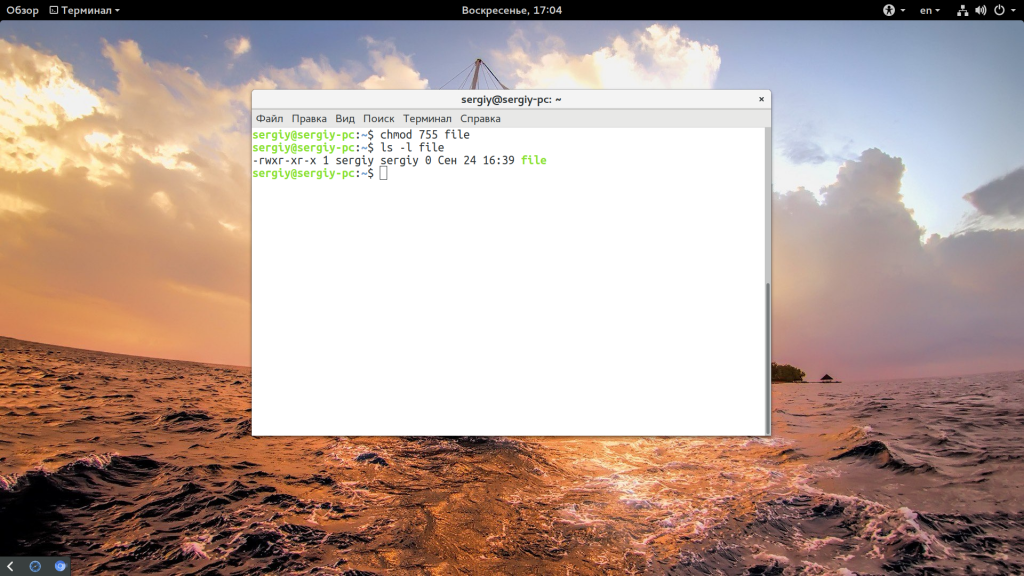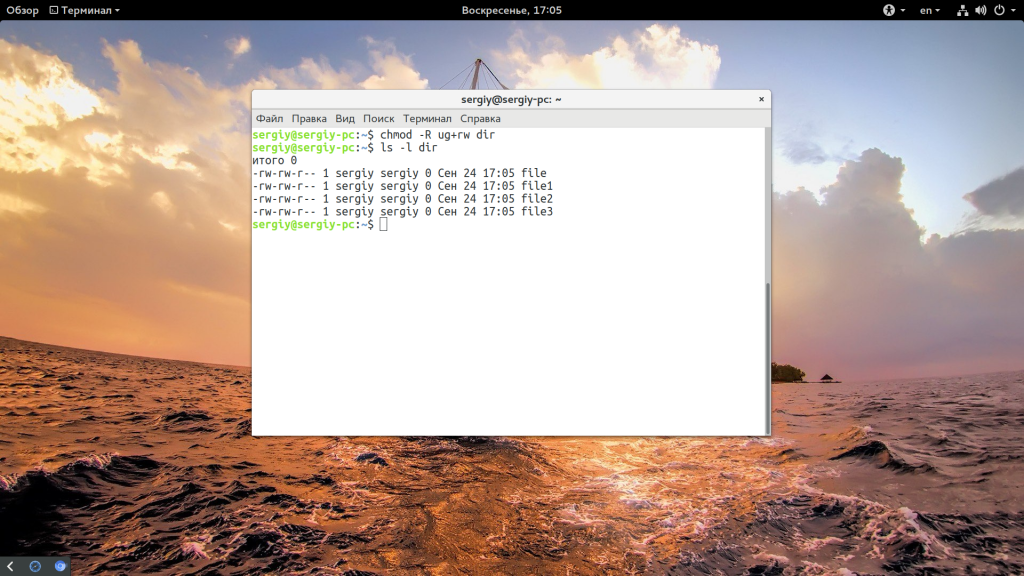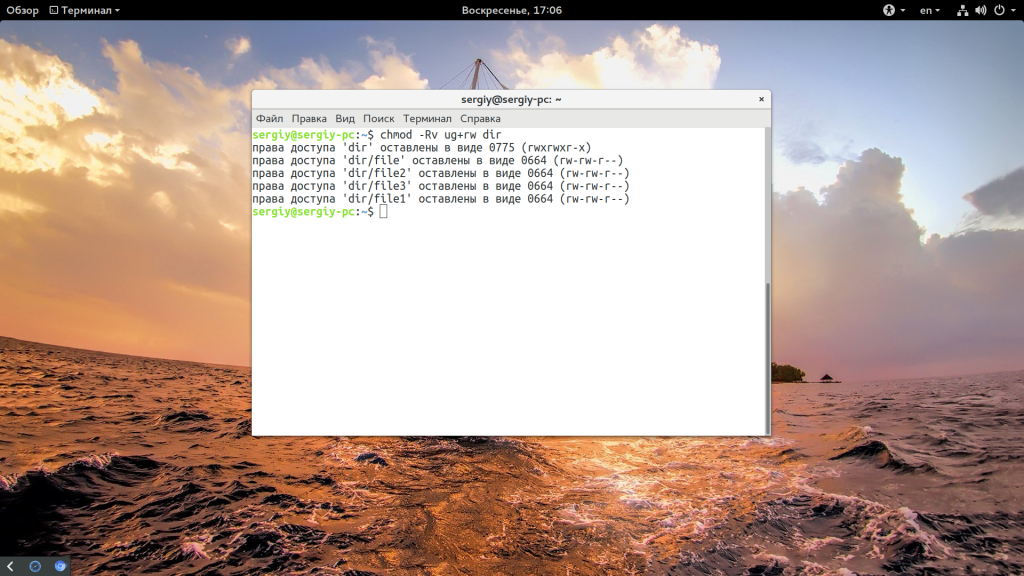Команда chmod Linux
Система полномочий в Linux имеет очень важное значение, поскольку благодаря ей можно разделять привилегии между пользователями, ограничить доступ к нежелательным файлам или возможностям, контролировать доступные действия для сервисов и многое другое. В Linux существует всего три вида прав — право на чтение, запись и выполнение, а также три категории пользователей, к которым они могут применяться — владелец файла, группа файла и все остальные.
Эти права применяются для каждого файла, а поскольку все в системе Linux, даже устройства, считаются файлами, то, получается что эти права применимы ко всему. Мы более подробно рассматривали как работают права доступа к файлам Linux в отдельной статье, а этой, я хочу остановиться на команде chmod, которая используется для установки прав.
Команда chmod Linux
Эта команда имеет типичный для команд linux синтаксис, сначала команда, затем опции, а в конце файл или папка, к которой ее нужно применить:
$ chmod опции права /путь/к/файлу
Сначала рассмотрим какими бывают права доступа linux и как они устанавливаются. Пред этим рекомендую прочитать статью про права, ссылка на которую есть выше. Есть три основных вида прав:
Также есть три категории пользователей, для которых вы можете установить эти права на файл linux:
Синтаксис настройки прав такой:
группа_пользователей действие в ид_прав
В качестве действий могут использоваться знаки «+» — включить или «-« — отключить. Рассмотрим несколько примеров:
- u+x — разрешить выполнение для владельца;
- ugo+x — разрешить выполнение для всех;
- ug+w — разрешить запись для владельца и группы;
- o-x — запретить выполнение для остальных пользователей;
- ugo+rwx — разрешить все для всех;
Но права можно записывать не только таким способом. Есть еще восьмеричный формат записи, он более сложен для понимания, но пишется короче и проще. Я не буду рассказывать как считать эти цифры, просто запомните какая цифра за что отвечает, так проще:
Права на папку linux такие же, как и для файла. Во время установки прав сначала укажите цифру прав для владельца, затем для группы, а потом для остальных. Например, :
- 744 — разрешить все для владельца, а остальным только чтение;
- 755 — все для владельца, остальным только чтение и выполнение;
- 764 — все для владельца, чтение и запись для группы, и только чтение для остальных;
- 777 — всем разрешено все.
Каждая из цифр не зависит от предыдущих, вы вбираете именно то, что вам нужно. Теперь давайте рассмотрим несколько опций команды, которые нам понадобятся во время работы:
- -c — выводить информацию обо всех изменениях;
- -f — не выводить сообщения об ошибках;
- -v — выводить максимум информации;
- —preserve-root — не выполнять рекурсивные операции для корня «/»;
- —reference — взять маску прав из указанного файла;
- -R — включить поддержку рекурсии;
- —version — вывести версию утилиты;
Теперь, когда вы знаете опции и как настраиваются права доступа chmod, давайте рассмотрим несколько примеров как работает команда chmod linux.
Примеры использования chmod
Я не буду приводить много примеров, так как там и так все более-менее понятно после пояснения правил создания выражений установки прав. Сначала самый частый случай — разрешить выполнения скрипта владельцу:
Или можно воспользоваться цифровой записью:
chmod 766 file
ls — l file
Недостаток цифровой записи в том, что вы не можете модифицировать уже существующие права доступа linux. Например, в первом варианте вы просто добавили флаг выполнения для владельца файла, а все остальные права оставили неизменными. В восьмеричном варианте мы полностью заменили текущие права новыми — все для владельца и чтение/запись для группы и остальных. Как видите, права установлены как и ожидалось. Теперь отключим выполнение владельцем:
Дальше разрешим только чтение всем, кроме владельца:
Файлы с правами 000 недоступны никаким пользователям, кроме суперпользователя и владельца. Вернем права обратно:
Такая же ситуация с файлами, владельцем которых вы не являетесь, если вы хотите изменить их права — используйте sudo. Из модификаторов прав вы можете конструировать любые последовательности, я думаю тут нет смысла разбирать их все. Для того чтобы поменять права на все файлы в папке используйте опцию -R:
chmod -R ug+rw dir
ls -l dir/
Также вы можете смотреть подробную информацию про вносимые изменения, например:
Выводы
В этой небольшой статье была рассмотрена команда chmod linux. Она очень часто используется наряду с такими командами, как chown и umask для управления правами. Надеюсь, эта информация была полезной для вас. Если у вас остались вопросы, спрашивайте в комментариях!

Обнаружили ошибку в тексте? Сообщите мне об этом. Выделите текст с ошибкой и нажмите Ctrl+Enter.
Linux permissions: An introduction to chmod
If you have ever worked Linux system, you for sure have dealt with files, and that means that you might have encountered messages like this one below:
localhost@user1$ cat /etc/sudoers cat: /etc/sudoers: Permission denied Or, similar to this, error messages like «You do not have the permissions to upload files to this folder,» which might have prevented you from reading, writing, or accessing a particular file. And, naturally, this error might have made you wonder—the first time you encountered this problem, at least—as to why you were denied access.
Let’s take a look into Linux file permissions and the ways to restrict them, plus play with files a little bit. When you list files in a particular directory in Linux, you might have seen r, w, and x, and wondered what these letters mean. They have tremendous significance in determining what exactly a particular user can do with a file.
Let’s take a look at an example:
localhost@user1$ ls -ltr chmod_directory/ total 0 -rw-r--r--. 1 creator creator 0 Jul 29 21:55 I_Can_Write.txt -rw-r--r--. 1 creator creator 0 Jul 29 21:55 I_Can_Execute.sh -rw-r--r--. 1 creator creator 0 Jul 29 21:55 I_Can_Access.txtDefault file permissions are rw-r—r— (from the umask value (covered later in the article)), as shown in the example above.
Each permission has a numeric value assigned to it:
These values are additive for each «triplet», meaning that a file permission of rw- has the value of 6 and rwx has the value of 7. As discussed above, any file that’s newly created, the default value is 644 (rw-r—r—), meaning that the file’s owner can read and write, and all others can only read this file. The first triplet is the permission for the file owner/creator, the second is for group permissions, and the third is for others (users outside of the owner/creator or a group with permissions). This setting makes sense for obvious reasons: The owner should have higher control over the file’s contents in order to both read and write to it. Others might want to read the contents but not modify them. Of course, you can change this setting with the chmod command, which is the focus of this article.
Great Linux resources
So to understand this concept in a simpler way, think of file permissions as a 3×3 matrix, where owners, groups, and others each have r, w, and x settings. In the above example:
- The file’s creator (owner/user) has read and write permissions: —rw-r—r—.
- The file’s group creator (group) has read permissions: -rw-r—r—.
- Others have read permissions represented by the last bits: -rw-r—r—.
Now, let’s see the default permission values for a directory. Let’s say the directory chmod_directory was created with the default permissions of 755. Unlike files, a directory has files in it. In order for anyone other than the owner to ‘ cd ‘ into the directory, it needs an execute permission, which in turn makes the directory:
- Readable, writable and executable by the owner (rwx is 7).
- Readable and executable by the group (r-x is 5).
- Readable and executable for others (r-x is 5).
Note: The r-x designation does NOT mean r minus x, it means read and execute but missing write. The — is a placeholder for a permission.
(Please take a minute to think about why this is the default behavior.)
Ok, now that you have learned the basics of file and directory permissions, let’s take a look into the chmod command, which helps with making permission changes for files and directories.
As mentioned in the man page:
This manual page documents the GNU version of chmod. chmod changes the file mode bits of each given file according to mode, which can be either a symbolic representation of changes to make, or an octal number representing the bit pattern for the new mode bits. The format of a symbolic mode is [ugoa. ][[+-=][perms. ]. ], where perms is either zero or more letters from the set rwxXst, or a single letter from the set ugo. Multiple symbolic modes can be given, separated by commas. A combination of the letters ugoa controls which users' access to the file will be changed: the user who owns it (u), other users in the file's group (g), other users not in the file's group (o), or all users (a). If none of these are given, the effect is as if a were given, but bits that are set in the umask are not affected. Using octal representation
For changing file permissions, you can either use octal representation (numeric), or symbolic representation (the letters). In octal representation, the first digit is for the user, the second digit is for the group, and the third digit is for others. Let’s look at two examples of setting permissions with octal representation to understand this concept.
Example 1: If you want to give read (4), write (2), and execute (1) permissions to both the user and group, and only read (4) permission to others, you can use:
Example 2: If you want to restrict write permissions to all others except the file’s owner, you can use:
Using symbolic representation
You can also change permissions using symbolic representation rather than numeric. Symbolic representation is assigning permissions to user (u), group (g), and others (o) using letters (symbols) and the letter designations: r, w, and x.
Let’s look at these examples again, but using symbolic representation.
Example 1: Read, write, and execute for the user and group, plus only read for others, maps as:
localhost@user1$ chmod ug+rwx,o+r
Example 2: Read, write, and execute for the user and only read permissions for group and others maps as:
localhost@user1$ chmod u+rwx,go+r
Awesome, I’m proud of you all: You have now mastered file permission concepts. But I’ll caution you that there are two dangerous scenarios that you might want to avoid, so keep this as a best practice while using chmod. Avoid using boundary cases, such as chmod 777 and chmod 000 . Using chmod 777 gives everyone rwx permissions, and it is generally not a good practice to give full powers to all the users in a system. The second case, I will leave you guys to figure out.
Using umasks
I will leave you guys with one more concept that you need to be aware of (umask) that decides the default permissions for a file. Overall, the default values are:
As you might remember, the default file permission value is 0644, and the default directory’s is 0755. The default umask value is subtracted from the overall file/directory default value. You can set the umask values in /etc/profile or in ~/.bashrc .
Wrapping up
Chmod is a great Linux command for manipulating file and directory permissions. With the concepts mentioned in this article, you are equipped with sufficient knowledge to handle permissions in Linux-based distros.

